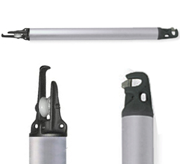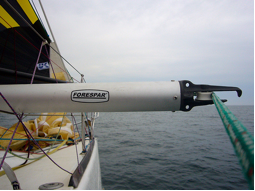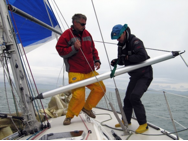Forespar's Point of View
Blogging About Life on the WaterMonthly Archives: October 2016
What’s a Spinnaker Strut?
And Why Do You Need One?
A spinnaker strut is a relatively short (usually aluminum) pole with one end fitting designed for mast attachment, and the other for running a line across a small internal pulley. Standard sizes range up to about seven feet in length and three or four inches in diameter. They look like this:
As its name implies, the strut is for use with a traditional symmetrical spinnaker. It will keep the afterguy (or the spin sheet you’re using as an afterguy) attached to the spinnaker pole away from lifelines, stanchions and other undesirable points on its way back to the stern.
The strut is usually attached to the mast via a padeye on the mast, and often held in position with a sail tie to a shroud
Sailors want a reaching strut because:
- With the afterguy riding across the sheave in the end of the strut, the pole is much easier to control and adjust. Eliminating the friction is important.
- The line will chafe as it rides across the lifeline, stanchions, etc. Decent line for sheets and guys starts at about 75 cents a running foot, and the good stuff at twice that. Unnecessarily replacing it gets old in a hurry.
- The load on the afterguy can be significant if it’s blowing. That can and will bend the lifeline and stanchions.
- Crew on the rail will be safer and happier without a loaded (and possibly weak) guy on their chests or backs.
And, more important – when sailing fairly close to the wind with the spinnaker, the pole is well forward. In a good breeze the afterguy or sheet is very heavily loaded. If that lifeline or stanchion (or both) bends enough, or breaks, the pole will slam forward into the forestay. Bad things can happen. Very bad things.
A reaching strut is easy to rig, and easy to use. Because it’s fairly short, it’s also easy to stow. And not expensive , especially when you consider the cost of a forestay or mast.
Keep Your Nose Up
One of the first times I ran outside the harbor on my own, the waves were small and relatively smooth. But when I returned a couple of hours later, the tide had changed against the wind, the chop had turned into waves, and the breeze had gone from eight to about fifteen knots. And, of course I was coming downwind with following sea. In a 14-foot centerboard boat. With all the vast experience and skill of a 12-year old.
Eased the centerboard up, surfed down the face of the wave, stuffed the bow and broached the boat. After what seemed like a dozen times almost righting the boat, a real sailor came up (in a power boat) and instructed me on getting the main in the boat, the boat upright and into the harbor, wet cold and alive. I’ve tried to repeat the experience in larger boats, but was unable to replicate the conditions, probably because there’s usually crew aboard who don’t want to get that wet, and I have many more years of experience driving boats. I’ve even tried to do the same thing with a power boat, almost succeeding due largely to inattention.
Three basic lessons learned for following seas:
- Trim the bow up. That’s why sailboats seem to keep the weight in the stern when running down the sea. If you’re in a power boat, pay attention to the trim tabs.
- Learn to surf the boat. Do not drive directly down the wave, because the bow will slow the boat when it hits the back of the wave ahead, and the following sea is likely to push your stern to the side, inducing that “I wanna broach ” motion.
- Unless you’re racing, try to find a spot on the back of the wave – a lot easier to do with a power boat – so you don’t get pushed around as much or as suddenly. In other words, slow down to the speed of the wave if you can. It’s safer and a whole lot more comfortable.
The oft used cliche “Slower is smoother, and smoother is fast” sounds odd, but it applies. You’ll reach your destination both drier, and happier.


